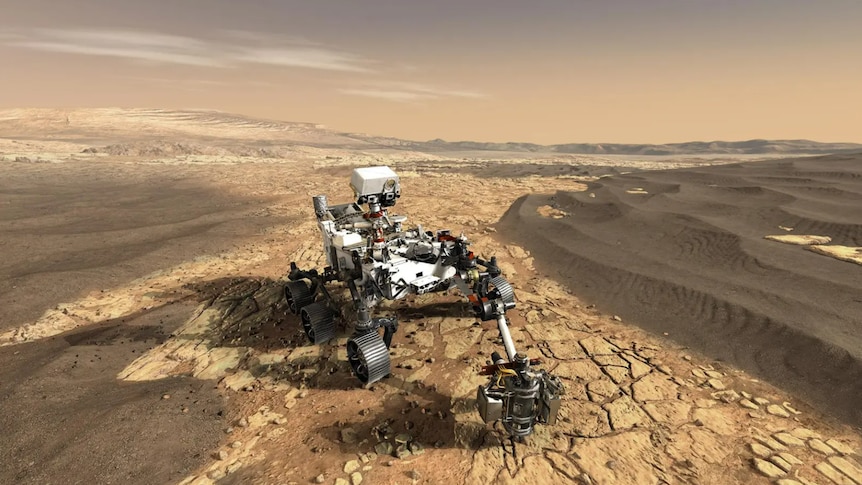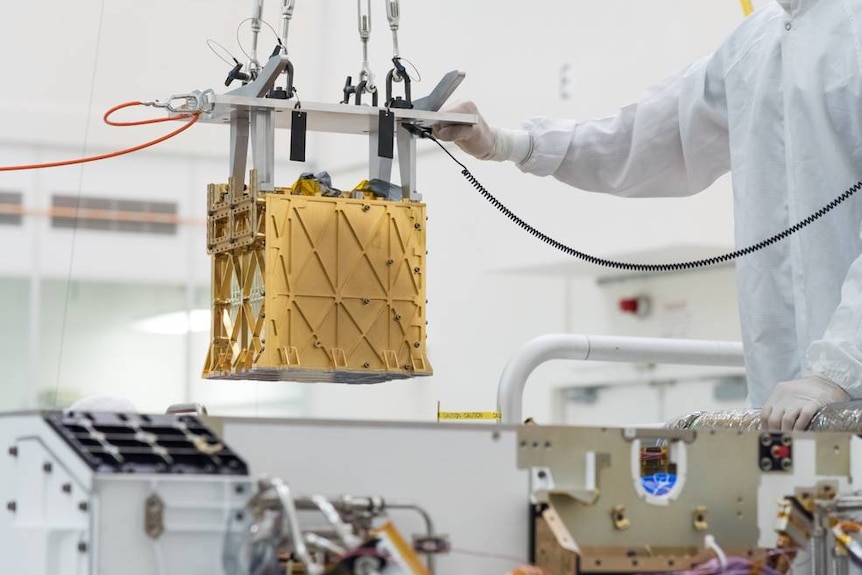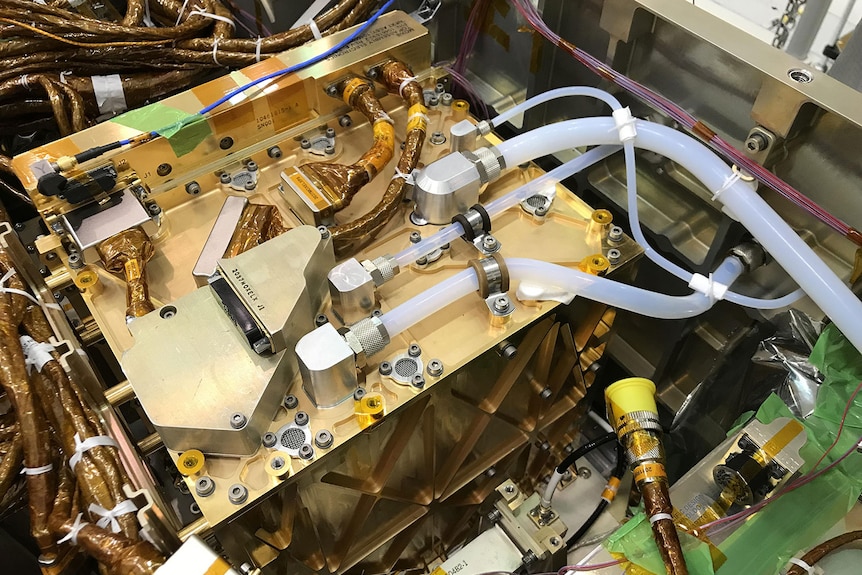Wednesday 31 Aug 2022

In an extraterrestrial first, NASA's instrument converts Martian materials into oxygen.(NASA/Jet Propulsion Laboratory )
An experiment from NASA has taken a small step towards making Mars habitable for humans.
NASA's instrument, the Mars Oxygen In Situ Resource Utilization Experiment, or MOXIE, has been successful in generating breathable oxygen on Mars using resources found on the Red Planet — a first for the experiment.
The lunch box-sized instrument has produced oxygen from the carbon dioxide in the Martian atmosphere seven times since landing on Mars in February 2021.
So what's new about this demonstration?
An experiment from NASA has taken a small step towards making Mars habitable for humans.
NASA's instrument, the Mars Oxygen In Situ Resource Utilization Experiment, or MOXIE, has been successful in generating breathable oxygen on Mars using resources found on the Red Planet — a first for the experiment.
The lunch box-sized instrument has produced oxygen from the carbon dioxide in the Martian atmosphere seven times since landing on Mars in February 2021.
So what's new about this demonstration?
More on Mars
There are glimpses of ancient Mars on present-day Earth
First high-res images from Mars landing released
The blue sunsets are spectacular but the radiation bites. Welcome to Mars
MOXIE’s oxygen production on Mars represents the first demonstration of “in-situ resource utilisation".
This is the practice of harvesting and using a planet’s materials to make resources that would otherwise have to be transported from Earth.
Massachusetts Institute of Technology (MIT) professor of aeronautics and astronautics and principal investigator for MOXIE, Jeffery Hoffman, said this is the first time MOXIE has used resources from the planet itself.
“This is the first demonstration of actually using resources on the surface of another planetary body, and transforming them chemically into something that would be useful for a human mission,” he said in a statement.
“It’s historic in that sense.”
First high-res images from Mars landing released
The blue sunsets are spectacular but the radiation bites. Welcome to Mars
MOXIE’s oxygen production on Mars represents the first demonstration of “in-situ resource utilisation".
This is the practice of harvesting and using a planet’s materials to make resources that would otherwise have to be transported from Earth.
Massachusetts Institute of Technology (MIT) professor of aeronautics and astronautics and principal investigator for MOXIE, Jeffery Hoffman, said this is the first time MOXIE has used resources from the planet itself.
“This is the first demonstration of actually using resources on the surface of another planetary body, and transforming them chemically into something that would be useful for a human mission,” he said in a statement.
“It’s historic in that sense.”
Engineers lowering MOXIE into the belly of NASA's Perseverance rover.
(NASA/Jet Propulsion Laboratory)
In each of its seven runs, MOXIE reached its goal of producing 6g of oxygen per hour — similar to the rate of a small tree on Earth, according to findings published in a new paper in the journal Science Advances.
MIT began developing Moxie in 2014.
The experiment rode to Mars along with NASA's Perseverance rover in 2020, landing on Jezero Crater in February 2021.
Researchers suggest a scaled-up version of MOXIE could be sent to Mars to continuously produce oxygen at the rate of several hundred trees, ahead of humans going to the planet.
How does it work? What would a scaled-up version look like?
Think of MOXIE as a similar process to producing oxygen and hydrogen from water in a fuel cell.
The instrument works by sucking in Martian air, filtering it, then using electrolysis to split carbon dioxide into oxygen and carbon monoxide.
After this, it purifies and combines the singular oxygen atoms to produce O2 — breathable oxygen.
Moxie then releases the oxygen and carbon monoxide back into the Martian atmosphere.

In each of its seven runs, MOXIE reached its goal of producing 6g of oxygen per hour — similar to the rate of a small tree on Earth, according to findings published in a new paper in the journal Science Advances.
MIT began developing Moxie in 2014.
The experiment rode to Mars along with NASA's Perseverance rover in 2020, landing on Jezero Crater in February 2021.
Researchers suggest a scaled-up version of MOXIE could be sent to Mars to continuously produce oxygen at the rate of several hundred trees, ahead of humans going to the planet.
How does it work? What would a scaled-up version look like?
Think of MOXIE as a similar process to producing oxygen and hydrogen from water in a fuel cell.
The instrument works by sucking in Martian air, filtering it, then using electrolysis to split carbon dioxide into oxygen and carbon monoxide.
After this, it purifies and combines the singular oxygen atoms to produce O2 — breathable oxygen.
Moxie then releases the oxygen and carbon monoxide back into the Martian atmosphere.
Researchers suggest a scaled-up version of MOXIE could be used to produce oxygen on Mars at the rate of several hundred trees.(NASA/Jet Propulsion Laboratory)
So far, MOXIE has shown that it can make oxygen at almost any time of the Martian day and year.
Michael Hecht, principal investigator of the MOXIE mission at MIT’s Haystack Observatory, said: “The only thing we have not demonstrated is running at dawn or dusk, when the temperature is changing substantially.
“We do have an ace up our sleeve that will let us do that, and once we test that in the lab, we can reach that last milestone to show we can really run any time," he said.
Researchers say a scaled-up version of MOXIE on a future Mars mission would pump that oxygen into some sort of storage tank for future use.
This means providing breathable O2 for astronauts, or liquid oxygen for the manufacture of rocket fuels.

So far, MOXIE has shown that it can make oxygen at almost any time of the Martian day and year.
Michael Hecht, principal investigator of the MOXIE mission at MIT’s Haystack Observatory, said: “The only thing we have not demonstrated is running at dawn or dusk, when the temperature is changing substantially.
“We do have an ace up our sleeve that will let us do that, and once we test that in the lab, we can reach that last milestone to show we can really run any time," he said.
Researchers say a scaled-up version of MOXIE on a future Mars mission would pump that oxygen into some sort of storage tank for future use.
This means providing breathable O2 for astronauts, or liquid oxygen for the manufacture of rocket fuels.
Take a peek inside the inner workings of the gold-plated MOXIE.
(NASA/Jet Propulsion Laboratory )
As MOXIE continues to churn out oxygen on Mars, engineers plan to push its capacity by increasing its production, particularly in the Martian spring, when atmospheric density and carbon dioxide levels are high.
“To support a human mission to Mars, we have to bring a lot of stuff from Earth, like computers, spacesuits, and habitats," Mr Hoffman said.
"But dumb old oxygen? If you can make it there, go for it — you’re way ahead of the game."
As MOXIE continues to churn out oxygen on Mars, engineers plan to push its capacity by increasing its production, particularly in the Martian spring, when atmospheric density and carbon dioxide levels are high.
“To support a human mission to Mars, we have to bring a lot of stuff from Earth, like computers, spacesuits, and habitats," Mr Hoffman said.
"But dumb old oxygen? If you can make it there, go for it — you’re way ahead of the game."
Posted 31 Aug 2022
No comments:
Post a Comment